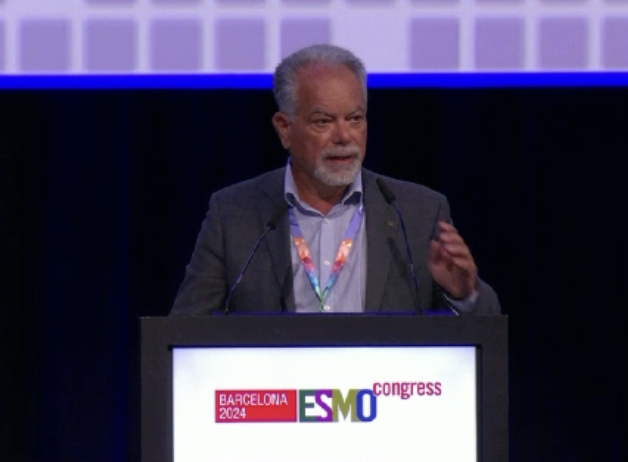Darolutamide + ADT, without docetaxel, shows efficacy benefits in mHSPC




 Prof Fred Saad
Prof Fred SaadDarolutamide plus androgen-deprivation therapy (ADT), without docetaxel, improves radiological progression-free survival (rPFS) and secondary efficacy outcomes vs placebo plus ADT in patients with metastatic hormone-sensitive prostate cancer (mHSPC), according to results of the global phase III ARANOTE trial presented at ESMO 2024.
rPFS and other efficacy benefits
The primary endpoint of rPFS showed a significant 46 percent risk reduction with darolutamide plus ADT vs placebo plus ADT (median, not reached [NR] vs 25.0 months; hazard ratio [HR], 0.54; 95 percent confidence interval [CI], 0.41–0.71; p<0.0001) after a median follow-up of 25.3 and 25.0 months in the respective arms. rPFS rate at 24 months was 70.3 vs 52.1 percent. [Saad F, et al, ESMO 2024, abstract LBA68; J Clin Oncol 2024;doi:10.1200/JCO-24-01798]
“Darolutamide’s rPFS benefit was consistent across subgroups, including patients with high- [HR, 0.60; 95 percent CI, 0.44–0.80] or low-volume [HR, 0.30; 95 percent CI, 0.15–0.60] disease,” said Professor Fred Saad of the Centre Hospitalier de l’Université de Montréal, University of Montreal, Canada, who presented the findings at ESMO 2024.
Median overall survival was NR in either arm at data cutoff for primary analysis, with a HR of 0.81 (95 percent CI, 0.59–1.12) suggestive of a benefit with darolutamide vs placebo.
Darolutamide plus ADT also delayed time to metastatic castration-resistant prostate cancer (median, NR vs 13.8 months; HR, 0.40; 95 percent CI, 0.32–0.51), time to pain progression (median, NR vs 29.9 months; HR, 0.72; 95 percent CI, 0.54–0.96), time to prostate-specific antigen (PSA) progression (median, NR vs 16.8 months; HR, 0.31; 95 percent CI, 0.23–0.41), and time to initiation of subsequent systemic therapy for prostate cancer (median, NR in both arms; HR, 0.40; 95 percent CI, 0.29–0.56) vs placebo plus ADT. More patients in the darolutamide vs placebo arm achieved PSA <0.2 ng/mL at any time during treatment (62.6 vs 18.5 percent).
Favourable safety profile
The incidence of treatment-emergent adverse events (TEAEs) was similar between the darolutamide and placebo arms (grade 3/4, 30.8 vs 30.3 percent; grade 5, 4.7 vs 5.4 percent; serious, 23.6 vs 23.5 percent).
“TEAEs associated with androgen receptor pathway inhibitors [ARPIs] were generally similar between arms,” said Saad. “Notably, the incidence of fatigue was lower with darolutamide vs placebo [5.6 vs 8.1 percent]. Fewer patients in the darolutamide vs placebo arm discontinued study drug due to TEAEs [6.1 vs 9.0 percent].”
An additional SoC
“Results of ARANOTE suggest that darolutamide plus ADT, without docetaxel, should become an additional standard of care [SoC] for mHSPC, on top of current SoC with darolutamide plus ADT and docetaxel,” commented Saad. [N Engl J Med 2022;386:1132-1142]
“Despite substantial evidence supporting the benefits of combination regimens for mHSPC, real-world prescribing patterns continue to show high use of ADT alone, even after regulatory approval of ARPIs,” noted the ARANOTE investigators. [J Clin Oncol 2024;doi:10.1200/JCO-24-01798] “In 2023, about 30 percent of mHSPC patients in the US and Germany still received ADT alone.” [J Clin Oncol 2024;doi:10.1200/JCO.2024.42.16_suppl.e1708; Urologie 2024;doi:10.1007/s00120-024-02410-7]
“The ARANOTE trial was designed to evaluate darolutamide plus ADT vs ADT, without docetaxel, to provide a new treatment option for patients with mHSPC,” said Saad.
A total of 669 mHSPC patients (median age, 70 years) with Eastern Cooperative Oncology Group performance status of 0–2, recruited from 15 countries across Asia, Australia, Canada, Europe, Latin America, South Africa, and New Zealand, were randomized 2:1 to receive darolutamide 600 mg BID plus ADT (n=446) or placebo plus ADT (n=223).
Baseline demographics and disease characteristics were similar between arms. About 31 percent of patients were Asian, 72.5 percent had de novo metastatic disease, and about 70 percent had high-volume disease.